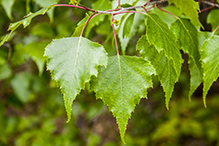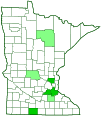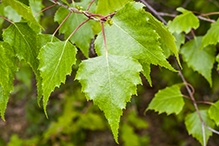gray birch
(Betula populifolia)
Conservation • Wetland • Description • Habitat • Ecology • Use • Distribution • Taxonomy
Conservation Status |
|
|||||||
| IUCN Red List | LC - Least Concern |
|||||||
| NatureServe | N5 - Secure |
|||||||
| Minnesota | not listed |
|||||||
Wetland Indicator Status |
||||||||
| Midwest | FAC - Facultative |
|||||||
| Northcentral & Northeast | FAC - Facultative |
|||||||
Description |
||
Gray birch is a small, bushy, fast-growing, deciduous tree rising usually on multiple trunks often from an old stump. It is short-lived, seldom surviving more than 50 years. Mature trees are usually The trunk is usually curved and leaning and is distinct nearly to the top of the crown. It has many small branches that persist as the tree develops, creating a crown that reaches close to the ground. The branches are short, slender, and contorted. Older branches are often more or less S-shaped. The crown is tall, narrow, irregular, and open. Bark on young trees is thin, smooth, dark reddish-brown, and shiny, with pale, horizontal pores (lenticels). On mature trees it is thin, smooth, grayish-white, and chalky, not shiny. It shows little or no peeling on its own and if forced will peel only with difficulty. The lenticels on mature bark are dark and greatly expanded horizontally. At each branch scar and at the base of each branch there is a dark, rough, triangular patch caused by the tree’s defensive response to the fungus Melanomma subdispersum. The twigs are slender, dark reddish-brown to gray, and hairless or sparsely hairy. They are rough to the touch, due to large, prominent, raised, warty lenticels and small, inconspicuous resin glands. They do not taste or smell like wintergreen. The leaf scars are small and half ellipse to crescent shaped. They have 3 bundle scars. The pith is pale, small, solid, and homogeneous (not diaphragmed). The lateral buds are light brownish-gray, gummy, and often hairy. They are widest in the middle, taper to narrow base, and taper to a point at the tip. There are no terminal buds. The leaves are borne on two distinct kinds of shoots. Long shoots are produced at the tip of the twig. They are fast growing and have well-spaced nodes. Spur shoots emerge from the widely-spaced leaf axils along the long shoot. They are very slow growing and have very little growth between nodes. Two types of leaves are produced: early leaves, also called preformed leaves; and late leaves, also called neoformed leaves. Preformed leaves overwinter in the bud and are fully formed or almost fully formed before bud burst in the spring. They are the first leaves to mature in the spring. They are produced on spur shoots and at the base of long shoots. Neoformed leaves are all of the subsequent leaves produced on long shoots. They are formed in the season they emerge from new tissue growing at the tip of the shoot. The leaves are deciduous and alternate but often appear opposite or whorled on young branchlets. They hang downward and tend to flutter in the wind. Their resemblance to leaves of quaking aspen (Populus deltoides) is the source of the species name populifolia. They are on slender, Male and female flowers are borne on the same tree and on the same branch. Male catkins are preformed in the late summer the year before they shed their pollen. They droop singly, rarely in pairs, from leafless branchlets formed at the tips of current year long shoots. They are greenish and about ¾″ long by late fall. They remain on the tree over the winter and elongate the following spring, eventually becoming 2⅜″ to 4″ long. They shed their pollen between April and May. Female catkins are also preformed but remain in the protective bud over the winter. In the spring they appear singly, upright, at the end of very short, leafy, lateral branchlets on current-year twigs. At pollination time they are oblong, ¾″ to ⅝″ long, and erect or ascending. The fruits are contained in mature seed catkins. Each seed catkin is cone-like, narrow, cylinder-shaped, blunt tipped, and ⅝″ to ¾″ long. The scales of the catkin are overlapping and densely hairy on the inner side, though this will not be visible without a hand lens. They are 1 ⁄16″ to ⅛″ long and have 3 lobes. The lateral lobes are broad, widely spreading, and bend backward. The central lobe is narrowly pointed and much shorter than the lateral lobes. The scales persist through at least part of the winter. The fruit is a tiny, two-winged nutlet (samara). The wings of the samara are almost hairless, much wider than the nutlet, and broadest near the middle. The samara matures from September to October and is dispersed from October to mid-winter by wind and gravity. |
||
Height |
||
20′ to 30′ |
||
Record |
||
Champion records are not maintained for non-native trees. |
||
Flower Color |
||
|
||
Similar Species |
||
Habitat |
||
Moist to moderately dry. Recently burned areas, abandoned pastures, roadsides, disturbed areas. Not shade tolerant. Sandy soil. |
||
Ecology |
||
Flowering |
||
April to May |
||
Pests and Diseases |
||
Birch-leaf blotchminer moth (Cameraria betulivora) |
||
Use |
||
|
||
Distribution |
||||
|
Sources The counties in light green on the map represent sightings that are not “outside of cultivation.” Itasca County: Forest History Center, Grand Rapids Rice County: Carleton College Cowling Arboretum, Northfield Stearns County: Bailey Herbarium at College of Saint Benedict/Saint John’s University, Collegeville |
|||
| 2/11/2020 | ||||
Nativity |
||||
Native to eastern United States and Canada, including Illinois. |
||||
Occurrence |
||||
Adventive |
||||
Taxonomy |
|||
| Kingdom | Plantae (Plants) | ||
| Division | Tracheophyta (Vascular Plants) | ||
| Subdivision | Spermatophytina (Seed Plants) | ||
| Class | Magnoliopsida (Dicots) | ||
Order |
Fagales (Beeches, Oaks, Walnuts, and Allies) | ||
Family |
Betulaceae (Birch) | ||
| Subfamily | Betuloideae | ||
Genus |
Betula (birches) | ||
| Subgenus | Betula (typical birches) | ||
| Section | Betula | ||
Subordinate Taxa |
|||
|
|||
Synonyms |
|||
|
|||
Common Names |
|||
fire birch gray birch grey birch oldfield birch white birch wire birch |
|||
Glossary
Axil
The upper angle where a branch, stem, leaf stalk, or vein diverges.
Catkin
A slim, cylindrical, drooping cluster of many flowers. The flowers have no petals and are either male or female but not both.
Lenticel
A corky, round or stripe-like, usually raised, pore-like opening in bark that allows for gas exchange.
Pinnately veined
With the veins arranged like the vanes of a feather; a single prominent midvein extending from the base to the tip and lateral veins originating from several points on each side.
Samara
A dry fruit consisting of a seed attached to a papery wing; one seeded in Elms and Ashes, two-seeded in Maples.

Slideshows |
||
| Gray Birch (Betula populifolia) Andree Reno Sanborn |
||

|
||
| Betula populifolia from American Native Nursery Mark Brownlee |
||
About
Published on Mar 5, 2013 Betula populifolia |
||

Visitor Videos |
|||
Share your video of this plant. |
|||
| This button not working for you? Simply email us at info@MinnesotaSeasons.com. Attach a video, a YouTube link, or a cloud storage link. |
|||
Other Videos |
|||
| Trees with Don Leopold - gray birch ESFTV |
|||
About
Published on Sep 23, 2011 |
|||
| Gray Birch Matt Bryant |
|||
About
Published on Mar 1, 2012 |
|||
| how to identify Betula populifolia Laura Deeter |
|||
About
Uploaded on Oct 2, 2008 short movie on the key id features |
|||
| Gray birch in Colchester is on National Big Tree Registry Norwich Bulletin |
|||
About
Published on Jun 1, 2012 Video by Ryan Blessing. |
|||

Visitor Sightings |
|||||
Report a sighting of this plant. |
|||||
| This button not working for you? Simply email us at info@MinnesotaSeasons.com. Be sure to include a location. |
|||||
|
|||||
MinnesotaSeasons.com Sightings |
|||||

|
Created: Last Updated: © MinnesotaSeasons.com. All rights reserved. |


